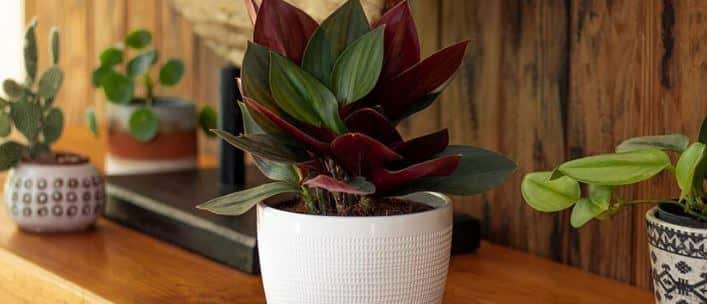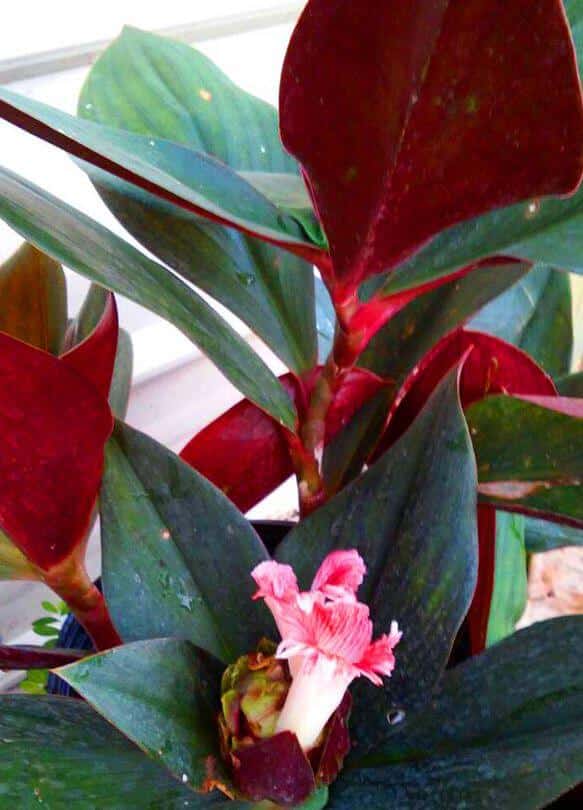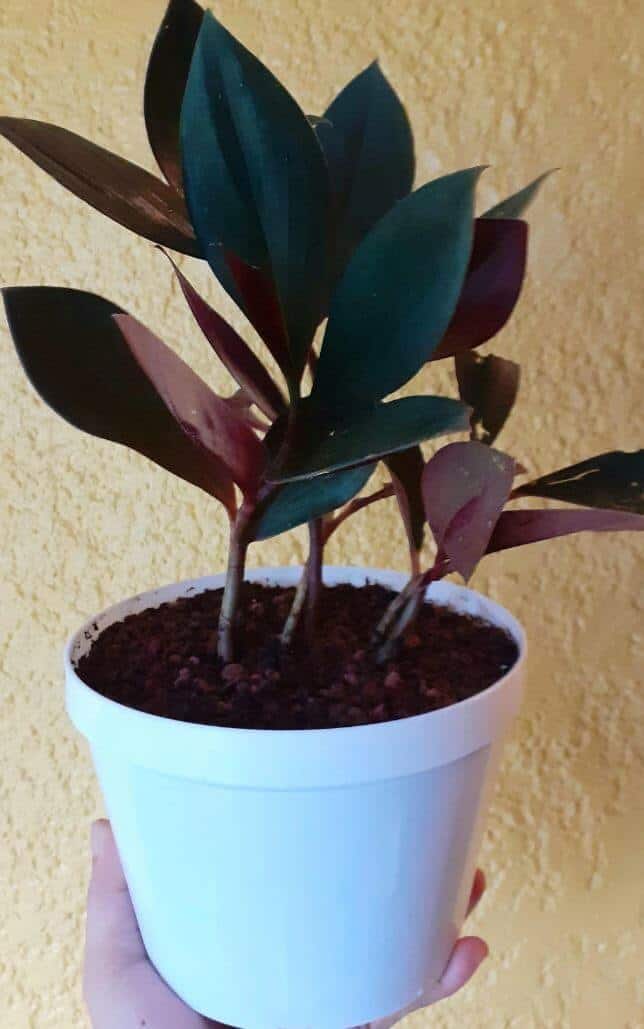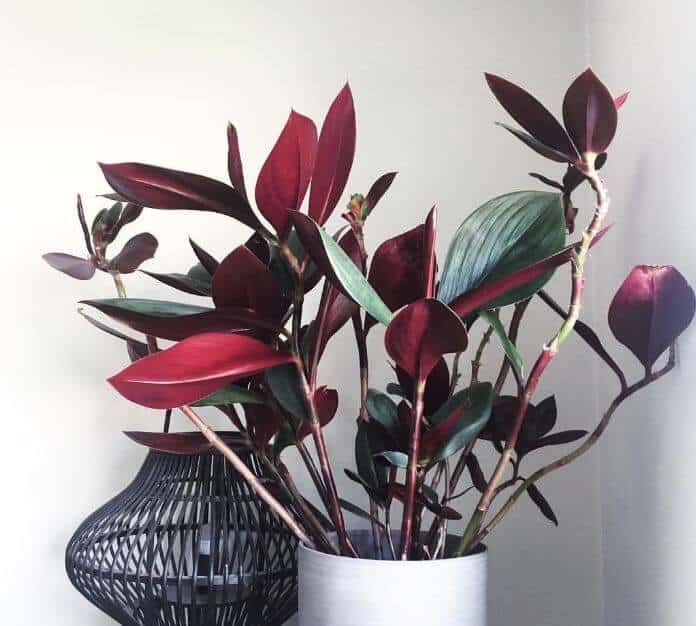Last Updated on January 6, 2023 by a Friendly Gardener
If you are searching for a unique and colorful houseplant, consider the Oxblood Ginger plant. An easy-to-care-for houseplant, the Oxblood Ginger delights with two stunning colors on a single plant. Foliage boasts a lush green hue on top and a deep purplish maroon underneath. To take full advantage of the striking leaf colors, this plant should be positioned just above eye level to fully appreciate the fascinating contrast between the rich green hue and the oxblood coloring.
Another attractive feature of this shrub is its tendency to maintain a full bushy appearance. As it matures, new shoots spring from the base of the plant conferring a fuller shrub-like presentation, although it still maintains a manageable size growing between one to two feet in height. It is an eye-catching addition to any décor when placed on tables, desks, or shelves that showcase its double-faced leaves.
About the Oxblood Ginger Plant

Botanically known as the Costus erythrophyllus, the Oxblood Ginger belongs to the Costaceae family and is a tropical plant native to northern Brazil, Ecuador, Colombia, and Peru. Aside from the unique coloring, foliage has a pleasing fleshy, waxy appearance as it spirals up plant stems. This species can be found used for medicinal purposes in the Dominican Republic and the U.S. for diabetes.
With the arrival of summer, this plant will flower and produce large blossoms that are red to pale pink till the fall. Once the flowers have passed, the ornamental value of the plant with its colorful foliage delights for the remainder of the year.
It prefers tropical and subtropical climates similar to its natural habitat, making it an ideal choice for an indoor garden. Common names include the Oxblood Ginger, the Red Wine Costus, and the Violet Spiral Flag.
Oxblood Ginger Plant Care

An exceptionally easy plant to care for, its principal requests of indoor home gardeners will be in terms of watering and humidity.
Soil
The Oxblood Ginger prefers a free-draining, fertile loamy soil. Ginger plants need slightly acidic soil beds with a pH measuring between 5.5 and 6.5.
Light
As a tropical understory plant growing beneath canopies of other vegetation, the Oxblood Ginger likes bright indirect light. Foliage can easily be damaged when exposed to direct sunlight with leaves turning brown. A location in the vicinity of a sunny window is preferable. If you do not have sufficient natural light, consider supplementing with a grow light.
Water
This is a plant that needs a regular watering schedule. Avoid allowing the soil bed to dry out completely. The Oxblood Ginger is also at risk for overwatering and will suffer if left to stand in water for any extended period. Root rot may set in with the plant drowning and eventually dying.
For those unsure of soil bed moisture, the use of a moisture meter is ideal, otherwise, dip a finger into the soil about two inches deep. If the soil feels damp to you, wait to water it again. Watering frequency will fluctuate during the year due to seasonal changes as well as because of the presence of indoor heating or air conditioning. The type and size of container used can also contribute to how often one needs to water. An occasional soaking with the drainage of excess water is optimal to guarantee a thorough watering of the entire root system.
If you are afraid of overwatering, consider using a terra cotta or clay pot to aid in moisture wicking. Ideally, collected rainwater is best for watering needs as most municipal water supplies contain chemicals and minerals.
Humidity
As a South American native, the Oxblood Ginger plant likes medium to higher humidity levels. This becomes particularly important if rooms are heated or air-conditioned.
A space humidifier can help with this, or you can install a pebble tray underneath your plant’s container. Other options include grouping the Oxblood Ginger plant with other houseplants to create a localized microclimate or placing a receptacle filled with water near your plant. Misting with rainwater is also beneficial. If the plant becomes too dry, it may enter dormancy.
Temperature
Home temperatures are congenial to the Oxblood Ginger plant. Temps should not fall below 50°F.
Feeding
Not a heavy feeder, this houseplant does not require anything special. It can be fed as little as once or twice yearly. Fertilize during the growing season in the spring and again in the summer. If you desire faster growth, feed more often. Use a liquid houseplant fertilizer diluted to approximately half-strength to prevent burning roots.
Pruning
The Oxblood Ginger does not require pruning per se. It is advisable to remove dead, dying, or yellowing foliage as a cure for the plant’s appearance. This will also allow the plant to dedicate its energies to healthy foliage.
Repotting the Oxblood Ginger Plant

Oxblood Ginger plants cultivated in containers will benefit from annual repotting to freshen soil and nutrients.
Oxblood Ginger Plant Propagation

These plants are rhizomatous perennials. For successful propagation, the plant’s rhizomes can be divided during the winter season. To separate the rhizomes, remove the plant gently from its pot and brush off excess soil with care. Fleshy clumping rhizomes should be visible with numerous shoots. Remove any rhizomes that appear to be unhealthy and divide the healthy rhizomes. Each section should feature at least two or three shoots. Plant the sections immediately in individual pots.
These plants can also be reproduced with stem cuttings that are 5 to 6 inches in length. Leaves should be removed, and stems placed in a flat position in a seeding mix or mulch and kept moistened until roots appear and then transplanted into pots.
Oxblood Ginger Plant Problems
Generally speaking, Oxblood Ginger plants do not seem to attract pests or diseases. If you move your plant outside onto a shaded patio or porch during the warmer seasons, you may find a visiting caterpillar munching away. Indoors, if conditions are on the drier side, a visit from spider mites is not unthinkable, even if rare.
Oxblood Ginger Plant Toxicity
The American Society for the Prevention of Cruelty to Animals-ASPCA does not list the Oxblood Ginger among plants toxic to humans or animals. Nonetheless, pets will tend to nibble, so it’s a good rule of thumb to place all houseplants in general out of the reach of small children and domestic animals. The raw rhizomes of spiral ginger species are, however, considered poisonous.
Oxblood Ginger Plant Benefits
The Costus erythrophyllus belongs to a category of plants known as “spiral gingers”. In traditional medicine, the parts of these plants are used in countries as varied as Tibet, India, Malaysia, Nepal, China, Indonesia, and Bangladesh among others to treat a series of maladies such as:
- Colds, congestion, and coughs
- Internal parasites
- Skin infections
- Rhizomes are used as a treatment for asthma, bronchitis, fever, rash, and even intestinal worms
- Rhizome juice has been used as a purgative or for dysentery
- Sap from young plant parts was used to treat ear and eye infections as well as treat diarrhea
- Appetite stimulant
- Diabetes
- Fertility control
- Constipation, bloating, menstruation
- Infectious conditions such as conjunctivitis, otitis, leprosy, etc.
Spiral ginger plants are considered to have Ayurvedic health benefits that include:
- Increasing urine production and waste elimination, nephritis, cystitis, and urinary stones
- Increasing menstruation when lacking
- Calming menstrual pain and discomfort
- Treating Urinary incontinence
- Treating urinary tract infections
Spiral Ginger is also mentioned in the Kama Sutra as a cosmetic ingredient to increase sexual attractiveness.

